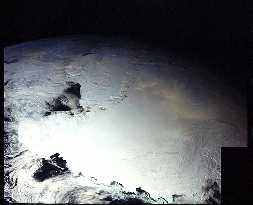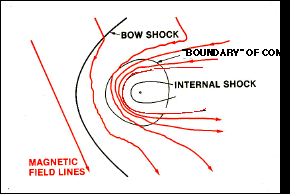This is a drawing showing the orbit of Pluto and the outer planets. It shows the planets on June 1, 1997. In the larger version at least, you can see dots next to the names indicating planet position. In 1997, Pluto was closer to the Sun than Neptune.
Click on image for full size
JPL/NASA
Pluto's Orbit
Pluto has the most eccentric orbit of all the planets in the solar system. The orbit draws within the orbit of Neptune, as can be seen in this drawing, making Pluto the 8th planet rather than the 9th planet for roughly 20 years at a time. Pluto was the 8th planet from January 1979 to February 1999. Neptune is now the 9th planet for over 200 years!
It takes 248 years for Pluto to complete its orbit. This means that a single Pluto year is 248 earth years long.
Pluto really does have the most eccentric orbit of all of the planets (e=0.248). Its orbit takes it to 49.5 AU (7.4 billion kilometers) at its farthest point from the Sun. And its orbit takes it as close as 29 AU (4.34 billion kilometers) to the Sun.
In addition to its peculiar orbit, Pluto and its moon Charon are locked together as they orbit each other, so that the same side of each body always faces the other.
You might also be interested in:

Pluto is a frigid ball of ice and rock that orbits far from the Sun on the frozen fringes of our Solar System. Considered a planet, though a rather odd one, from its discovery in 1930 until 2006, it was
...more
Of all the planets and moons in the solar system, Pluto and Charon are the two which resemble each other the most closely. They are almost the same size, and they are very close together. They are so
...more
Pluto is so far away, and has never been explored. Questions to answer about Pluto include the following: What are the geologic features of the surface. (pictures of the surface) If there are bare spots,
...more
It may seem hard to believe that Pluto could have an atmosphere because it is so cold at 39 AU, where Pluto resides, but it does. Because there are times when Pluto is closer to the sun than is Neptune
...more
Astronomers are beginning to organize a search for more moons of Pluto. Pluto has only one known moon, Charon, but astronomers think there might be other moons orbiting Pluto that haven't yet been discovered.
...more
No one knows whether or not Pluto has a magnetosphere. Scientists were very surprised to find that Jupiter's icy moon Ganymede had a magnetosphere because it is hard to explain how an icy body can develop
...more
Pluto has // Call the moon count function defined in the document head print_moon_count('pluto'); known moons. Charon, the largest by far, was discovered in 1978 by the American astronomer James Christy.
...more













